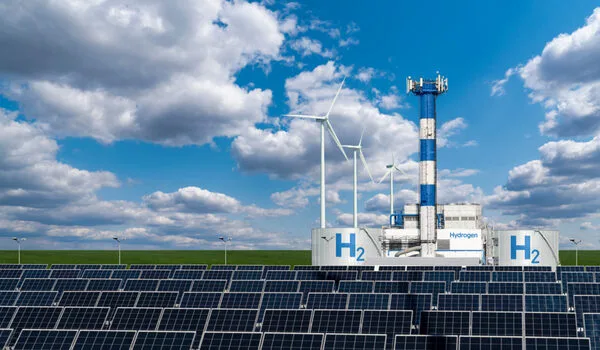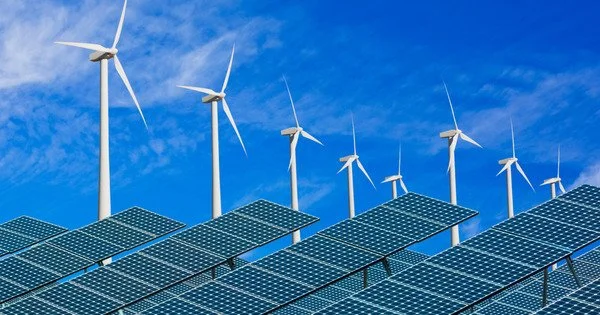Hydrogen can be produced sustainably through the use of solar power by using an electrolyzer to split water into hydrogen and oxygen. The process works by using electricity from solar panels to power the electrolyzer, which breaks down the water molecules into hydrogen and oxygen gas. The hydrogen can then be stored and used as a fuel source, while the oxygen is released back into the atmosphere.
There are several benefits to producing hydrogen through solar power. First, it is a clean and renewable energy source, as it only produces water as a byproduct. Second, it can be used to store excess solar energy that would otherwise be lost. Finally, hydrogen can be used in a variety of applications, including fuel cell vehicles, power generation, and industrial processes.
However, it is important to note that while the production of hydrogen through solar power is a promising technology, it is still in the early stages of development and has not yet been widely adopted.
A new type of solar panel developed at the University of Michigan has achieved 9% efficiency in converting water into hydrogen and oxygen, simulating an important step in natural photosynthesis. Outside, it represents a significant advancement in technology, being nearly ten times more efficient than previous solar water-splitting experiments.
We reduced the size of the semiconductor by more than 100 times compared to some semiconductors that only work at low light intensity. Our technology could produce very cheap hydrogen.
Peng Zhou
The biggest advantage, however, is that it lowers the cost of sustainable hydrogen. This is made possible by shrinking the semiconductor, which is typically the most expensive component of the device. The self-healing semiconductor developed by the team can withstand concentrated light equivalent to 160 suns.
Humans currently produce hydrogen from the fossil fuel methane, consuming a significant amount of fossil energy in the process. Plants, on the other hand, use sunlight to extract hydrogen atoms from water. As humanity attempts to reduce its carbon footprint, hydrogen is appealing as a standalone fuel as well as a component in sustainable fuels made from recycled carbon dioxide. It is also required in many chemical processes, such as the production of fertilizers.
“In the end, we believe that artificial photosynthesis devices will be much more efficient than natural photosynthesis, providing a path toward carbon neutrality,” said Zetian Mi, a U-M electrical and computer engineering professor who led the study published in Nature.
The outstanding result comes from two advances. The first is the ability to concentrate the sunlight without destroying the semiconductor that harnesses the light.

“We reduced the size of the semiconductor by more than 100 times compared to some semiconductors that only work at low light intensity,” said Peng Zhou, the study’s first author and a U-M research fellow in electrical and computer engineering. “Our technology could produce very cheap hydrogen.”
The second method involves using both the higher energy part of the solar spectrum to split water and the lower energy part of the spectrum to provide heat that promotes the reaction. The magic is enabled by a semiconductor catalyst that improves with use, resisting the degradation that such catalysts typically experience when used to drive chemical reactions with sunlight.
In addition to handling high light intensities, it can thrive in high temperatures that are punishing to computer semiconductors. Higher temperatures speed up the water splitting process, and the extra heat also encourages the hydrogen and oxygen to remain separate rather than renewing their bonds and forming water once more. Both of these helped the team to harvest more hydrogen.
Zhou used a lens the size of a house window to focus sunlight onto an experimental panel only a few inches across for the outdoor experiment. The semiconductor catalyst was covered in a layer of water within that panel, bubbling with the hydrogen and oxygen gasses it separated.
The catalyst is made of nanostructures of indium gallium nitride grown on a silicon surface. The light is captured by the semiconductor wafer, which converts it into free electrons and holes – positively charged gaps left behind when electrons are liberated by the light. The nanostructures are peppered with nanoscale metal balls 1/2000th of a millimeter in diameter that use electrons and holes to help direct the reaction.
A simple insulating layer on top of the panel keeps the temperature at a toasty 75 degrees Celsius, or 167 degrees Fahrenheit, warm enough to encourage the reaction while remaining cool enough for the semiconductor catalyst to function properly. The outdoor version of the experiment, which had less consistent sunlight and temperature, achieved a 6.1% efficiency in converting solar energy into hydrogen fuel. Indoors, however, the system achieved 9% efficiency.
The team plans to tackle the next challenges by increasing efficiency and producing ultrapure hydrogen that can be directly fed into fuel cells.
















